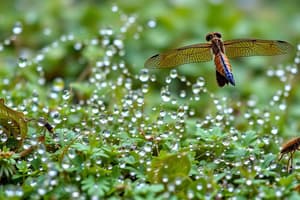Podcast
Questions and Answers
What defines a population in ecological terms?
What defines a population in ecological terms?
- All organisms of different species living together
- A group of organisms of the same species living in a particular area (correct)
- All living and non-living components interacting in a specific location
- The maximum number of species an ecosystem can support
Which of the following is an example of a biotic factor affecting a population?
Which of the following is an example of a biotic factor affecting a population?
- Extreme temperatures
- Soil type
- Drought conditions
- Availability of mates (correct)
What is the 'biotic potential' of a species?
What is the 'biotic potential' of a species?
- The maximum reproductive potential under ideal conditions (correct)
- The average lifespan of a species in the wild
- The minimum rate of reproduction under ideal conditions
- The capacity of a species to survive in harsh conditions
Which of the following would be considered a limiting factor in population dynamics?
Which of the following would be considered a limiting factor in population dynamics?
What does 'density-dependent factor' refer to in population dynamics?
What does 'density-dependent factor' refer to in population dynamics?
Which of the following best describes an ecosystem?
Which of the following best describes an ecosystem?
What typically happens to populations when ideal conditions are maintained?
What typically happens to populations when ideal conditions are maintained?
Which of the following represents abiotic factors impacting populations?
Which of the following represents abiotic factors impacting populations?
What characterizes exponential population growth?
What characterizes exponential population growth?
What is the current population density of Canada as stated?
What is the current population density of Canada as stated?
What has been a significant trend in global population growth since the mid-1800s?
What has been a significant trend in global population growth since the mid-1800s?
What are the two root causes of global environmental problems identified?
What are the two root causes of global environmental problems identified?
What is the consequence of overpopulation as described?
What is the consequence of overpopulation as described?
What is the relationship called when both species benefit from the interaction?
What is the relationship called when both species benefit from the interaction?
Which risk category describes a species that is no longer found in the wild in Canada but exists elsewhere?
Which risk category describes a species that is no longer found in the wild in Canada but exists elsewhere?
Where is Canada's population primarily concentrated?
Where is Canada's population primarily concentrated?
What type of interaction occurs when one organism, the parasite, derives nourishment from another organism, the host, which is harmed?
What type of interaction occurs when one organism, the parasite, derives nourishment from another organism, the host, which is harmed?
What must be improved to address human overpopulation?
What must be improved to address human overpopulation?
What does overpopulation complicate in terms of resources?
What does overpopulation complicate in terms of resources?
What happens to populations that fall below a critical threshold regarding endangerment or extinction?
What happens to populations that fall below a critical threshold regarding endangerment or extinction?
Which of the following is an example of commensalism?
Which of the following is an example of commensalism?
What does the term 'environmental resistance' refer to?
What does the term 'environmental resistance' refer to?
Which of the following species is classified as endangered due to habitat loss and high predation rates?
Which of the following species is classified as endangered due to habitat loss and high predation rates?
Which category of species status indicates that there is insufficient scientific information to support a designation?
Which category of species status indicates that there is insufficient scientific information to support a designation?
What defines a density-independent factor in population ecology?
What defines a density-independent factor in population ecology?
What is the primary role of environmental resistance in population dynamics?
What is the primary role of environmental resistance in population dynamics?
What does carrying capacity refer to in an ecosystem?
What does carrying capacity refer to in an ecosystem?
How can carrying capacity be altered?
How can carrying capacity be altered?
Which of the following is an abiotic limiting factor?
Which of the following is an abiotic limiting factor?
What is the difference between intraspecies and interspecies competition?
What is the difference between intraspecies and interspecies competition?
Which of the following correctly describes limiting factors in an environment?
Which of the following correctly describes limiting factors in an environment?
How does environmental degradation impact carrying capacity?
How does environmental degradation impact carrying capacity?
Flashcards are hidden until you start studying
Study Notes
Ecology & Population Dynamics
- Ecology: Study of interactions between organisms and their living and non-living environment.
- Abiotic Factors: Non-living factors influencing organisms (e.g., temperature, sunlight, water).
- Biotic Factors: Living factors influencing organisms (e.g., predators, prey, competition).
- Population: Group of organisms of the same species living in a particular area.
- Population Dynamics: Studies changes in population sizes and the factors influencing them.
Biotic Potential & Limiting Factors
- Biotic Potential: Maximum rate of reproduction a species can achieve under ideal conditions with unlimited resources.
- Limiting Factors: Environmental factors that restrict population growth (e.g., food, shelter, predators, disease).
- Density Dependent Factors: Factors that impact a population based on its density (e.g., predation, competition).
- Density Independent Factors: Factors that impact a population regardless of its density (e.g., natural disasters, climate change).
Carrying Capacity
- Carrying Capacity: Maximum number of individuals a specific environment can sustainably support.
- Dynamic Carrying Capacity: Can be altered by technology or environmental changes.
- Environmental Resistance: Limiting factors that reduce population growth rate.
Examples of Limiting Factors
- Abiotic Limiting Factors: Chemical/mineral availability, climate, energy supply.
- Biotic Limiting Factors: Competition (intra- and interspecies), invasive species, predation, symbiosis (mutualism, commensalism, parasitism).
Tracking Populations & Conservation Status
- Tracking Populations: Field ecologists monitor population sizes for wildlife management and conservation.
- Seven Risk Categories: Extinct, Extirpated, Endangered, Threatened, Special Concern, Not at Risk, Data Deficient.
Human Population Dynamics
- Exponential Growth: Human population has grown rapidly in recent centuries.
- Population Density: The number of individuals per unit area (Canada's density is 3.5 people/square kilometer).
- Consumption Crisis: Developed countries consume a disproportionate share of global resources.
- Overpopulation: Human population exceeding Earth's carrying capacity.
- Consequences of Overpopulation: Strain on resources, environmental damage, and threats to human health and wildlife.
Studying That Suits You
Use AI to generate personalized quizzes and flashcards to suit your learning preferences.




